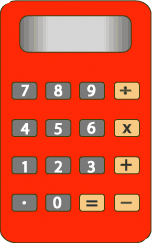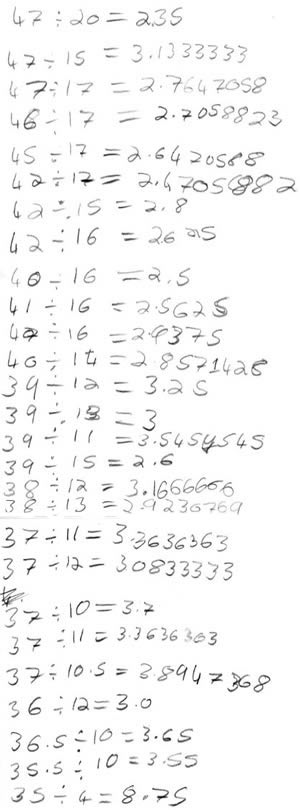Copyright © University of Cambridge. All rights reserved.
Forgot the Numbers
If you are a teacher click here for a version of the problem suitable for classroom use, together with supporting materials. Otherwise, read on ...
On my calculator I divided one whole number by another whole number and got the answer $3.125$.
I know that both numbers were less than $50$, but can't remember what they were.
Can you work out what they were?
Once you've had a chance to think about it, click below to see how four different pupils began working on the task.
Here is Gemma and Flo's work:
Richard wrote the following:

He explained:
"I multiplied $3.125$ by $1$, then I tried multiplying $3.125$ by $2$, then I multiplied $3.125$ by $3$ ..."
Here is the start of Thomas' work:
I first looked at the number $0.125$ and worked out what fraction of $1$ it is. It turned out that it was an eighth.
Can you take each of these starting ideas and develop it into a solution?
Click here for a poster of this problem.
Why do this problem?
This task has the potential to address many aspects of number and calculation, including the inverse relationship between multiplication and division, and the relationship between division and decimal fractions. The richness of the activity comes in the many different approaches which could be used to solve it and discussion of these different methods is emphasised
in these notes. You may well need to spend a couple of lessons on this activity.
Possible approach
Pose the problem orally, or project the text onto a screen, without mentioning the examples of how some children started. Give the class a few minutes to consider, individually, how they might go about tackling the problem, then pair them up and suggest that they talk to their partner about their ideas so far. Try to stand back and observe, and resist the temptation to make
helpful suggestions!
Allow pairs to work on the task so that you feel they have made some progress, but do not worry if they have not completed it or if they report being stuck. The aim at this stage is for everyone to 'get into' the problem and work hard on trying to solve it, but not necessarily to achieve a final solution.
At a suitable time, hand out this (doc pdf) to pairs. Suggest to the class that when they've finished or can't
make any further progress, they should look at the sheet showing three approaches used by children working on this task. Pose the question, "What might each do next? Can you take each of their starting ideas and develop them into a solution?". You may like pairs to record their work on large sheets of paper, which might be more easily shared with the rest of the class in the
plenary.
Allow at least fifteen minutes for a final discussion. Invite some pairs to explain how the three different methods might be continued. You may find that some members of the class used completely different approaches when they worked on the task to begin with, so ask them to share their methods too. You can then facilitate a discussion about the advantages and disadvantages of
each. Which way would they choose to use if they were presented with a similar task in the future? Why?
Key questions
Tell me about this approach. What do you think he/she/they were doing?
How do you think this will help to solve the problem?
What do you think he/she/they would have done next?
Possible extension
Can they apply what they have learnt to a similar problem, where the answer is $3.375$, $4.5$, $4.1$?
Can they make up a similar question and solve it?
Possible support
Have calculators available for pupils to use, should they wish.


